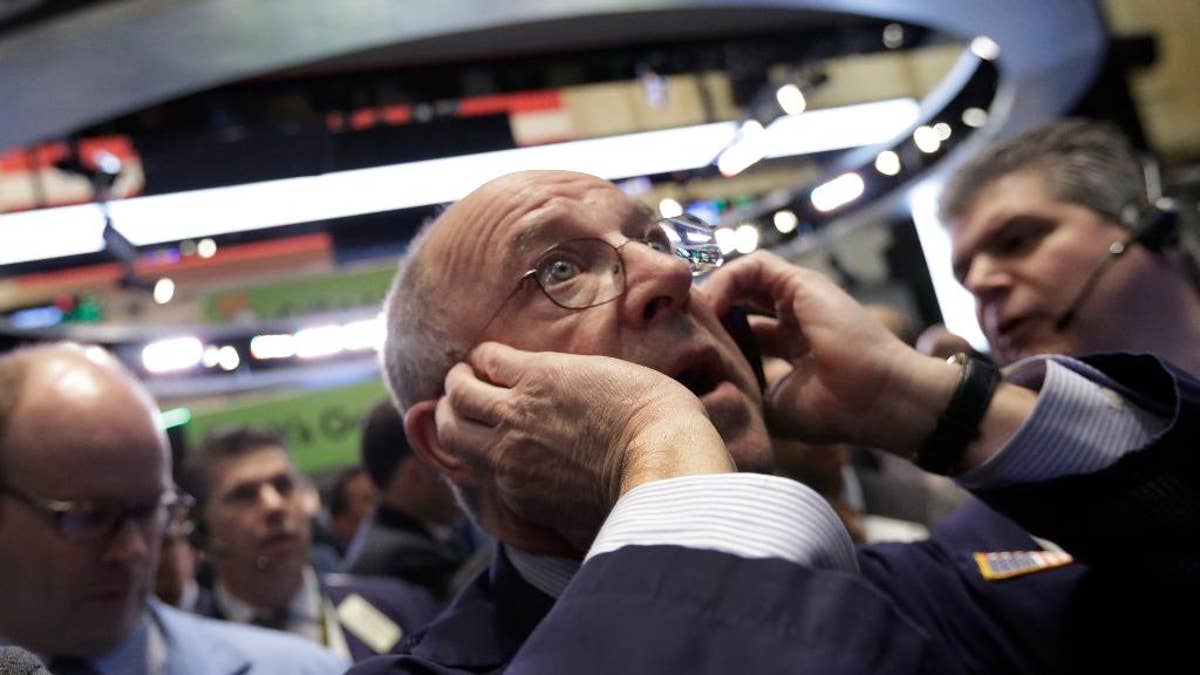
Trader Frederick Reimer works on the floor of the New York Stock Exchange, Wednesday, April 1, 2015. U.S. stocks moved lower in early trading Wednesday, extending losses from the day before. A report indicating that U.S. businesses slowed their pace of hiring last month weighed on the market. (AP Photo/Richard Drew) (The Associated Press)
Stock markets in the U.S. and around the world swooned Monday, responding to losses posted in Asia overnight. The Dow Jones traded off more than 1,000 points Monday morning before retracing about half that decline. The U.S. markets are now in correction territory, down more than 10% from recent highs. The swift collapse, after months of unusual serenity, shocked investors here and overseas. It shouldn’t have; the trigger – a slowdown in China -- has been visible (but largely ignored) for months.
The stock market in China dropped 8.5% overnight – a shocking follow-on to losses posted last week as investors came face-to-face with the reality that the world’s number two economy is not growing at its 7% targeted rate. The Shanghai index is down 40% since June, after soaring 140% last year. It has been clear for some time that Beijing was faltering, with the authorities hyping local stock markets and more recently devaluing the Yuan to boost growth. But, the possibility that China would no longer fuel global expansion, as it has done for decades, took a while to percolate through to investors. It is way too early to project the hit that multinational companies (and emerging markets) may sustain from a slowing China; global stock markets are suggesting it could be big.
The other looming problem worrying investors is that there’s not much the U.S. or other governments can do about a weakening economy. The reason that many have advocated for raising interest rates, even during this especially sluggish recovery, is that six plus years of easing have left the monetary quiver empty. Rates cannot go lower – in the U.S. or in the dozens of countries that have similarly relied on monetary policy to sustain growth.
For most governments around the world, that leaves fiscal policy as the best weapon to ward off another slowdown. In the U.S., though, increased government spending is a political no-go zone. Though our deficits have declined from the trillion-dollar-plus level incurred during the financial crisis, we are still borrowing roughly $500 billion a year, and the national debt continues to grow. A Republican Congress will not allow deficits to ramp back up again. In Europe, excessive budget gaps brought on by the Great Recession are similarly controversial, and would be opposed.
There is no question that China is running out of steam, and that the authorities in Beijing are in panic mode.
For six years the stock market has levitated on zero percent interest rates, enjoying one of the longest and most profitable bull runs on record, courtesy of the Federal Reserve. For years, investors have wondered when the party would end. As Fed Chair Janet Yellen signaled the likelihood of a rate increase this fall, traders were paralyzed, watching the approaching disaster like someone unable to jump out of the path of a freight train. All it took to shake the markets was a trigger, and Beijing delivered that in spades.
There is no question that China is running out of steam, and that the authorities in Beijing are in panic mode. Second-quarter growth was officially reported at 7%; no one believes the figure. Exports in the quarter dropped 8.3%, imports were off 8.1%, car sales were down 6.6%. When a country begins to lie about its economic results, you can bet there’s a problem.
The inevitable impact of rising labor rates and the exodus of manufacturing from China to neighboring countries resulted in the 2011 decision to shift to a consumer-driven economy. The wealth of China’s emerging middle class was meant to fuel continued growth. As export gains slowed, the consumer would pick up the slack. The problem is, the Chinese consumer is a saver, not a spender. The new model is not working.
Worried leaders decided to boost consumer spending by touting the stock market, luring in newcomers last year by softening restrictions on buying shares with borrowed money. As a result, the market soared, fueled by margin purchases. Now, millions of first-time investors have lost not only their money, but also their confidence.
That markets in Europe and the U.S. have followed China lower is not surprising. China’s economic problems undercut the prospects for growth in developed and emerging countries alike, and consequently for earnings for companies around the world. Guidance from companies like Apple, for which China is an important market, will likely be lowered. It is too early to know how much damage will be done, as estimates for China’s growth are highly speculative at this point. The direction is clear.
The good news is that U.S. markets were valued above the long-term average before the selling wave hit, but they were not wildly expensive. With the recent sell-off, and assuming that there is a modest further downdraft, valuations will be in comfortable territory, based on current earnings estimates. The market gurus at ISI Group put S&P earnings for next year at $120 and the market’s price/earnings ratio at 16. They describe current levels as “fair value.” However, note that those estimates will probably drop.
There are always uncertainties facing investors. Today’s list includes not only the economic uncertainty in China, but the ongoing Greek drama, the collapse in oil prices, and the contraction in Japan, where the economy shrank in the last quarter. The tone of the markets has swiftly moved from carefree to dire. Most likely, investors will find a middle ground, as stocks descend to attractive prices. The sell-off is not unique or even unusual. That doesn’t make it any the less painful. It still hurts like hell.




















